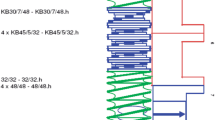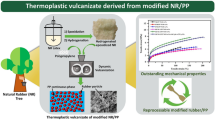Abstract
The role of various vulcanizing systems on the curing characteristics, mechanical properties, morphology and dynamic mechanical analysis of natural rubber and recycled ethylene–propylene–diene rubber blends was investigated. Accelerated sulfur-vulcanizing systems (semi-EV and EV), peroxide, and mixed sulfur/peroxide-vulcanizing systems (semi-EV/peroxide and EV/peroxide) were observed and compared. The blends were processed on a two-roll mill, and a fixed amount of carbon black was also incorporated. Amongst the blends, accelerated sulfur-vulcanizing systems exhibited higher torques, state of cure, tensile strength and elongation-at-break, in comparison with the peroxide-vulcanizing system, whereas the tensile modulus, hardness and cross-link density showed lower trend. In the mixed sulfur/peroxide-vulcanizing systems, it showed intermediate behavior to the individual sulfur- or peroxide-vulcanizing systems. This was associated to the interference of peroxide during the cross-linking formation. SEM micrographs of semi-EV-vulcanizing system exhibited more roughness and cracking path indicating that higher energy was required towards the fractured surface. The high cross-link density observed from the swelling study could be verified from the storage modulus (E′) where peroxide vulcanized blends provided a predominant degree of cross-linking followed by semi-EV, semi-EV/peroxide, EV and EV/peroxide-vulcanizing systems, respectively. The glass transition temperature (T g) depicted at maximum peak of mechanical loss factor (tanδ max), indicating that semi-EV-vulcanizing system showed highest T g value. The T g values can be ordered as semi-EV > peroxide > semi-EV/peroxide > EV > EV/peroxide-vulcanizing systems. The T g of rubber vulcanizates can be increased due to the restriction of molecular movement such as cross-link density.






Similar content being viewed by others
References
Ismail H, Nordin R, Noor AM (2002) The comparison properties of recycle rubber powder, carbon black, and calcium carbonate filled natural rubber compounds. Polym-Plast Technol Eng 41:847–862
Ismail H, Nordin R, Noor AM (2003) The effects of recycle rubber powder (RRP) content and various vulcanization systems on curing characteristics and mechanical properties of natural rubber/RRP blends. Iran Polym J 12:373–380
Mortazavi SB, Rasoulzadeh Y, Yousefi AA, Khavanin A (2010) Properties of modified bitumen obtained from vacuum bottom by adding recycled waste polymers and natural bitumen. Iran Polym J 19:197–205
Sutanto P, Laksmana FL, Picchioni F, Janssen LPBM (2006) Modeling on the kinetics of an EPDM devulcanization in an internal batch mixer using an amine as the devulcanizing agent. Chem Eng Sci 61:6442–6453
Ismail H, Galpaya D, Ahmad Z (2009) The compatibilizing effect of epoxy resin (EP) on polypropylene (PP)/recycled acrylonitrile butadiene rubber (NBRr) blends. Polym Test 28:363–370
Zulkepli NN, Ismail H, Rashid A (2009) Effects of different particle sizes of recycled acrylonitrile-butadiene rubber and its blend ratios on mechanical and morphological properties and curing characteristics of SBR/NBRr blends. Iran Polym J 18:139–148
Hayeemasae N, Ismail H, Azura AR (2013) Blending of natural rubber/recycled ethylene–propylene–diene monomer: cure behaviors and mechanical properties. Polym-Plast Technol Eng 52:501–509
Nabil H, Ismail H, Azura AR (2013) Comparison of thermo-oxidative ageing and thermal analysis of carbon black-filled NR/virgin EPDM and NR/recycled EPDM blends. Polym Test 32:631–639
Nabil H, Ismail H, Azura AR (2014) Optimisation of accelerators and vulcanising systems on thermal stability of natural rubber/recycled ethylene–propylene–diene monomer blends. Mater Design 53:651–661
Dluzneski PR (2001) Peroxide vulcanization of elastomers. Rubb Chem Technol 74:451–492
Loan LD (1967) Mechanism of peroxide vulcanization of elastomers. Rubb Chem Technol 40:149–176
Thitithammawong A, Nakason C, Sahakaro K, Noordermeer JWM (2007) Thermoplastic vulcanizates based on epoxidized natural rubber/polypropylene blends: selection of optimal peroxide type and concentration in relation to mixing conditions. Eur Polym J 43:4008–4018
Thitithammawong A, Nakason C, Sahakaro K, Noordermeer JWM (2007) NR/PP thermoplastic vulcanizates: selection of optimal peroxide type and concentration in relation to mixing conditions. J Appl Polym Sci 106:2204–2209
Nakason C, Worlee A, Salaeh S (2008) Effect of vulcanization systems on properties and recyclability of dynamically cured epoxidized natural rubber/polypropylene blends. Polym Test 27:858–869
Thitithammawong A, Uthaipan N, Rungvichaniwat A (2012) The influence of mixed conventional sulfur/peroxide vulcanization systems on the mechanical and thermal properties of natural rubber/polypropylene blends. J Elast Plast 44:419–432
Flory PJ, Rehner J (1943) Statistical mechanics of cross-linked polymer networks II. swelling. J Chem Phys 11:521–526
Ismail H, Ruhaizat T (1997) Concentration effect of palm oil fatty acid on curing characteristics and mechanical properties of carbon black filled natural rubber compounds. Intern J Polym Mater 38:249–261
Ismail H, Anuar H (2000) Palm oil fatty acid as an activator in carbon black filled natural rubber compounds: dynamic properties, curing characteristics, reversion and fatigue studies. Polym Test 19:349–359
Phadke AA, Bhowmick AK, De SK (1986) The effect of cryoground rubber on properties of natural rubber. J Appl Polym Sci 32:4063–4074
Phadke AA, Bhattacharya AK, Chakraborty SK, De SK (1983) Studies of vulcanization of reclaimed rubber. Rubb Chem Technol 56:726–735
Mathew G, Singh RR, Lakshminarayanan R, Thomas S (1996) Use of natural rubber prophylactics waste as a potential filler in styrene–butadiene rubber compounds. J Appl Polym Sci 61:2035–2050
Ishiaku US, Chong CS, Ismail H (2000) Cure characteristics and vulcanizate properties of a natural rubber compound extended with convoluted rubber powder. Polym Test 19:507–521
Burgoyne MD, Leaker GR, Krekic Z (1976) The effect of reusing ground flash and scrap rubber in parent compound. Rubb Chem Technol 49:375–378
Sae-oui P, Sirisinha C, Thepsuwan U, Thapthong P (2007) Influence of accelerator type on properties of NR/EPDM blends. Polym Test 26:1062–1067
Coran AY (2003) Chemistry of the vulcanization and protection of elastomers: a review of the achievements. J Appl Polym Sci 87:24–30
Coran AY (1965) Vulcanization. Part VII. Kinetics of sulfur vulcanization of natural rubber in presence of delayed-action accelerators. Rubb Chem Technol 38:1–14
Coran AY (1964) Vulcanization. Part VI. A model and treatment for scorch delay kinetics. Rubb Chem Technol 37:689–697
Gee G (1947) Tensile strength of pure gum natural rubber compounds. J Polym Sci 2:451–462
Schuring DJ, Futamura S (1990) Rolling loss of pneumatic highway tires in the eighties. Rubb Chem Technol 63:315–367
Ismail H, Pasbakhsh P, Ahmad Fauzi MN, Abu Bakar A (2009) The effect of halloysite nanotubes as a novel nanofiller on curing behaviour, mechanical and microstructural properties of ethylene–propylene–diene monomer (EPDM) nanocomposites. Polym-Plast Technol Eng 48:313–323
Medalia AI (1986) Electrical conduction in carbon black composites. Rubb Chem Technol 59:432–454
Trexler HE, Lee MCH (1986) Effect of types of carbon black and cure conditions on dynamic mechanical properties of elastomers. J Appl Polym Sci 32:3899–3912
Nair TM, Kumaran MG, Unnikrishnan G, Pillai VB (2009) Dynamic mechanical analysis of ethylene–propylene–diene monomer rubber and styrene–butadiene rubber blends. J Appl Polym Sci 112:72–81
Acknowledgments
One of the authors (H. Nabil) gratefully acknowledges the personal financial support under Graduate Assistant Scheme and Postgraduate Research Grant Scheme (PGRS) provided by Institute of Postgraduate Studies (IPS), UniversitiSains Malaysia (Account Number: 1001/PBAHAN/8045014). Also, acknowledges the research grant of Exploratory Research Grant Scheme (ERGS), Ministry of Higher Education (MOHE), Malaysia (Account Number: 203/PBAHAN/6730066) for the great support.
Author information
Authors and Affiliations
Corresponding author
Rights and permissions
About this article
Cite this article
Nabil, H., Ismail, H. & Azura, A.R. Properties of natural rubber/recycled ethylene–propylene–diene rubber blends prepared using various vulcanizing systems. Iran Polym J 23, 37–45 (2014). https://doi.org/10.1007/s13726-013-0197-4
Received:
Accepted:
Published:
Issue Date:
DOI: https://doi.org/10.1007/s13726-013-0197-4




